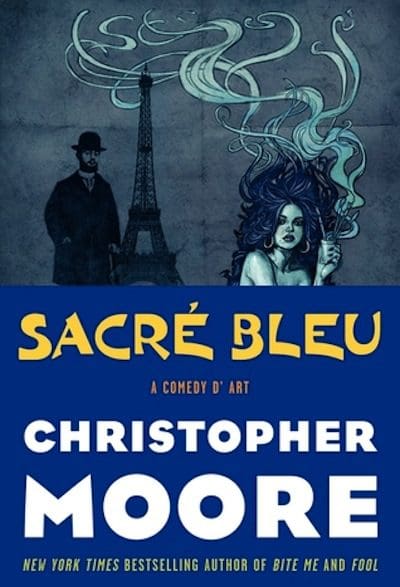 Zis book, she is beautiful.
Zis book, she is beautiful.
No, truly, despite ze cheesy French accent, I’m 100% serious.
Sacre Bleu, A Comedy D’Art is funny (Chris Moore’s signature fare), but it’s also sweet, and loving in a way that Moore’s work … isn’t always. I love it. I really, really do.
We start with Vincent Van Gogh’s murder. Yeah, you read me right—not suicide, MURDER (my poor Vinny baby). This book is about the color blue. Part murder mystery, part fantasy, part historical/biographical fiction, part romance, and all comedy, Sacre Bleu centers around the community of Impressionist painters in Montmartre—Vincent Van Gogh, Toulouse, Cezanne, Pissaro, Monet, Seraut, and the fictional baker/painter Lucien Lessard—a mysterious Colorman, and the magical, enigmatic, ultramarine Bleu.
Did I tell you that I love this book? I feel like I should say it again.
I love this book.
I mean, I was doomed to love this book (Moore did this to me. On purpose). He just went down the list, really.
It’s about artists? Check. The artists in questions are sometimes mad/tortured and always in love with color? Check. My favorite of those (Vince!), is in it? Check. The Muse is a BAMF? Check. There are cave paintings? Check. There’s buddy comedy nonsense in it? Check. It’s funny? Check. It would make an excellent crossover with Jasper Fforde’s Shades of Grey? Check (but no, seriously. Chris and Jasper, write that book together, please). THAT’S PRACTICALLY MY WHOLE CHECKLIST!!!!
I stood zero chance.
But the thing that really got me was that, like the artists he fictionalizes in this book, Moore loves his subjects. You can just tell. He really likes Bleu (although I’m not always so fond of her propensity for stripping—otherwise, she’s pretty awesome), he likes Lucien (and really, who wouldn’t), and he loves Toulouse, Vincent, and Monet. Don’t worry: the book’s not saccharine, it doesn’t come out sappy or anything, there’s just this heart runs as an undercurrent throughout the book that makes the characters more whole. They’re still funny (sometimes lewdly, mostly cleverly), they’re still violent and nutty and unrestrained, but they’re clearly more than just the butt of Moore’s jokes. And, hey, I don’t know Mr. Moore personally, so maybe I’m just confusing my love of the characters for his, but regardless, if it’s not love, then there’s an astounding compassion for the fictionalized artists.
I’ve read some of Christopher Moore’s stuff before (You Suck, A Love Story; Lamb: The Gospel According to Biff, Christ’s Childhood Pal; A Dirty Job), and first off, let me say, I liked them fine, they were funny, but … overall? Eh. I probably won’t re-read them. But this one… this one is different. It’s brilliant. Second of all, there’s always some empathy and give—I haven’t read a Moore character that was just a joke—but it’s nothing like what Moore gives to Monet and Vincent Van Gogh. And the humor and sensibilities Moore endows them with, if possible, makes me love them more.
And maybe you don’t quite get how I feel about Vince, but let me tell you, that’s impressive.
It’s that care and empathy that makes the book more than just a funny book, and allows it to be a really great book that’s fun, witty, engaging, and homey.
The only possible negative things I can think to say about this book are that it’s not the Most Hysterical Comedy book I’ve ever read, and it’s not the Most Touching Story, and it’s not the Most Thrilling Murder Mystery that was ever written. But this book is irreverently, lovingly genre-bending, and it was clearly wasn’t shooting for any of those silly fake commendations anyway. It was aiming to be the best Comedy D’Art ever. And it is.
You should read this book. It will make your day brighter, and further endear the Impressionists to you, and give you a great book to go back to if you’re ever feeling blue* and need a pick-me-up.
*Yeah. I went there. Bad Puns Activate!
